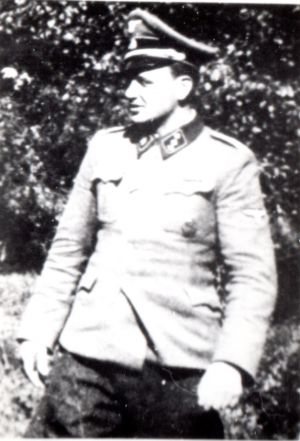Kurt Hubert Franz

Kurt Franz in Treblinka
Kurt Hubert Franz - Commandant of Treblinka 1943
Kurt Franz was born on 17 January 1914 in Dusseldorf where he attended elementary school from 1920 to 1928. After leaving school he trained first as a master butcher and then as a restaurant chef in the ‘Hirschquelle’ restaurant, and then in the ‘Hotel Wittelsbacher Hof’ in Dusseldorf. He did not take the final qualifying examination.From 1935 -1937, Franz served his draft, and upon honourable discharge in October 1937 he joined the Waffen –SS, serving for two years in the 6th Battalion of the SS- Totenkopfstandarte Thüringen, based at the Buchewald concentration camp, near Weimar.
In November 1939, Franz and a group of 10 other SS-NCO’s from the Death Heads Division were summoned to the Führer’s Chancellery on Voss Strase in Berlin. They were seconded to the ‘Chartiable Foundation for Institutional Care,‘ the camouflage organisation that managed the ‘T4‘ euthanasia programme in the Third Reich. Franz was asigned as a cook in four of the six euthanasia institutions, serving at Grafeneck, Brandenburg, Hartheim and Pirna – Sonnenstein. In March 1942, Franz was ordered to report to SS- Brigadeführer Odilo Globocnik, SS- undPolizeiführer in Lublin, and was then posted to the Belzec death camp. In Belzec, Franz was initially employed as the garrison cook, but within a short time Christian Wirth, the commandant, assigned him to train the Ukrainian- SS guard unit. On 20 April 1942, on the occasion of the Führer’s 53rd birthday, Franz was promoted to the rank of SS- Oberscharführer.
Sometime during the dates of 19-21 August 1942 Wirth, who was now the Inspector of the SS Sonderkommando Aktion Reinhardt, ordered Franz to the Treblinka death camp as deputy camp commandant, where once again he supervised the Ukrainian –SS guards.Kurt Franz’s physical appearance – tall, handsome, with fair hair and blue eyes, and a round, almost baby-face – led to him being nicknamed by the prisoners ‘Lalka,’ the Polish word for doll. However, beneath the good looks there lurked an evil personality and his constant sadistic treatment of the Jews in Treblinka, quickly made him feared as the most murderous and cruellest of all the SS in the camp. On his daily rounds, Franz was accompanied by Barry, a Saint Bernhard cross, trained by Franz to attack and maim prisoners on his master’s command. Barry came to Treblinka from the Sobibor death camp, and it is possible that Stangl brought him with him when he was transferred to Treblinka, at the same time as Franz. Kurt Franz and the dog Barry are mentioned frequently in statements by Treblinka survivors, and both were feared for their proclivity to inflict pain and injury.
During the spring of 1943, Franz was promoted to the rank of SS- Untersturmführer and during this time at Treblinka, he was responsible for ensuring a zoo was built, as well as a relaxation area for the SS, and other construction projects. On the day of the prisoner’s revolt in Treblinka on 2 August1943, he had taken a party of SS and Ukrainian guards swimming in the River Bug, but returned to the camp, once the revolt had started. After the revolt, Stangl was transferred and Franz was made responsible for the liquidation of the death camp, which lasted from 27 August 1943 until November 1943. After the final liquidation of the few remaining Jewish prisoners, and the demolition of the camp buildings, Franz went to the Sobibor death camp, but he was only there for a short while. He was then assigned to Trieste and Goriza in Northern Italy, where he was head of a Home Guard (Landesschutz) school.
In May 1945, Franz was arrested in Austria, by the American forces, but escaped to Germany, where he was re-arrested again by the Americans, but later released. His service in the ‘T4’ euthanasia programme and ‘Aktion Reinhardt’ were not known at the time. He returned to Dusseldorf, where he was employed as a construction worker, before returning to his pre-war profession as a restaurant chef. He was arrested in his home in December 1959, on suspicion of being involved in war crimes and crimes against humanity at Treblinka.
Franz was the main defendant at the First Treblinka Trial in Dusseldorf during 1964 -1965 and he was sentenced to life imprisonment on 3 September 1965, for ‘participation in at least 900,000 murders.’ He was released due to ill health in 1993, after having served 28 years of his sentence. Kurt Franz died in an old people’s home in Northrhine- Westphalia on 4 July 1998. He was 84 years old.
Sources
C.Webb & M. Chocholaty, The Treblinka Death Camp, Ibidem- Verlag, Stuttgart, 2014
Y. Arad, Belzec, Sobibor, Treblinka, Indiana University Press, Bloomington and Indianapolis, 1987
Kurt Franz – Personal File – NARA, Washington DC.
Photograph – Ghetto Fighters House, Israel
© Holocaust Historical Society 2014


